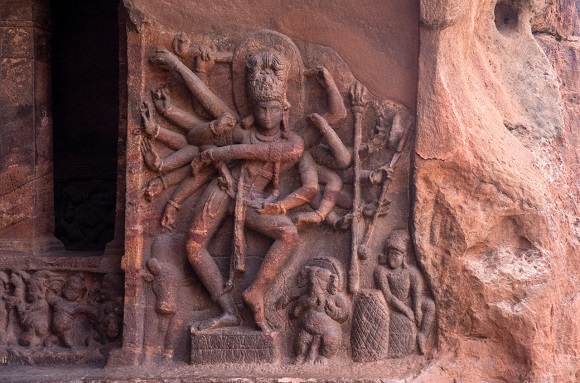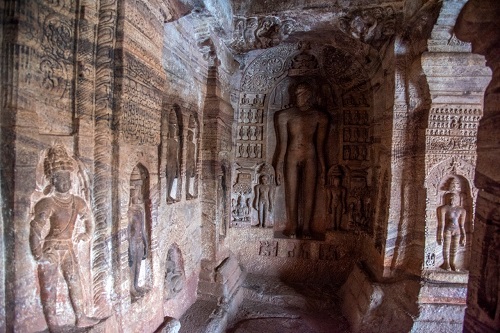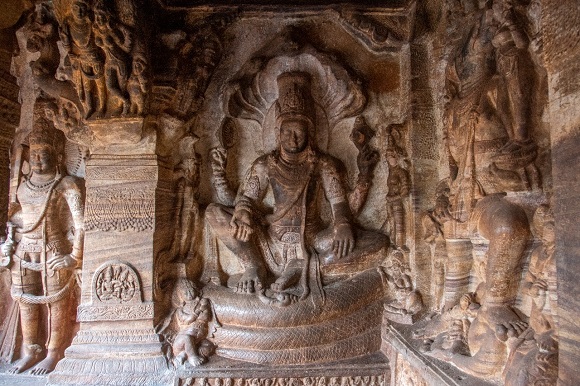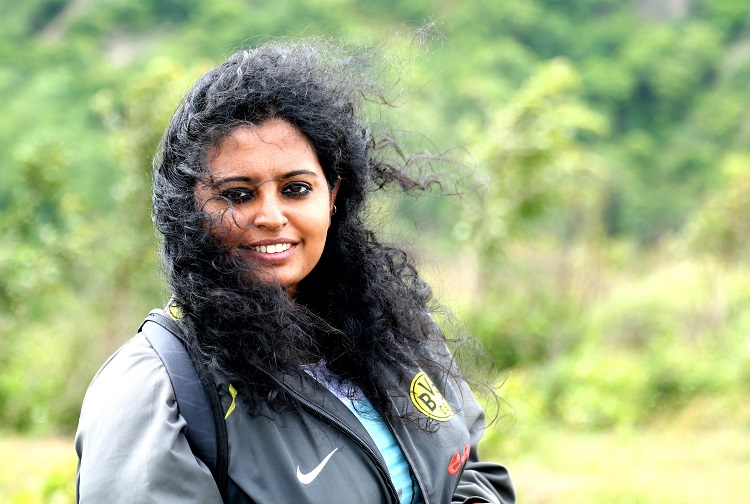Ayers Rock in Central Australia is a massive natural formation of red-sandstone enlisted by UNESCO as a World Heritage Site. The region contains an abundance of natural springs, streams, marshes, caves with vegetable-dyed cave paintings and rock carvings. To experience a spectacular view of this massive hillock glow into red at the times of maturing sun and during the Sunset, tourists who visit the nearby Kata-Tutja National Park flock here in multitudes. Likewise, the reddish cliffs in Badami, a historical town in north Karnataka, are also illuminated by the twilight dawns and dusks. While the Ayers Rock is named after an Australian Bureaucrat, Badami derived its name from the Hindi word of Almond; “badam” – denoting the colour of the pale-red-sandstone ridges, which is a landmark of the town. From historians’ point of view, the word Badami is a derivative of Vatapi. Vatapipura, the capital center was flourished during the period of the Chalukya Dynasty who ruled from 5th to 8th AD.
Winding roads from all directions through, vast agricultural lands of sunflower, mustard seeds, mice, millets then through Badami Town leads to the abode of Badami Hills. Out of the four cave temples engraved in Badami cliffs, the fourth cave is attributed to the Jain cult. The first one is dedicated to Lord Shiva, the second and third cave temples are devoted to Lord Vishnu. The rock-cut cave temples on the lap of the hillock and other structural temples that survived in the surroundings show the efflorescence of art, culture, and the mastered engineering skills during that period in Badami.


According to the mythological allusions Lord Siva has 32 hands. One can find a distinctive manifestation of a dancing Siva figure on the entrance of the First cave, which is dedicated to Siva on its right sidewall. The 18-handed Dancing Siva, 9 on the left and 9 on the right, is unique and rarest of the rarest one among the Nataraja figures. These 18 hands formulate 81 dancing postures mentioned in Natyasastra of Sage Bharata. From the main hall, one can see the sanctum sanctorum where a Shivalinga is seen. The ceiling of the cave has a skilfully carved five-headed coiled serpent, the divine Adishesha. The presence of the Ardha-nareeshwara figure and the importance given to it symbolizes the equal status enjoyed by the women. The ornamental decorations on the pillars make anyone bow to its expounded artistic excellence. Harihara and Dwara-palakas (door guards) are commonly seen in many Siva temples, but Siva and his consort Parvati on riding pose sit on the Nandi bull is a rare sort of figure.


Siva-sub-cave on the right side has “Vatapi-Ganesh” carved on the wall having distinctive features with total contrast to a normal Ganesh figure. Unlike other appealing Ganesha Idols “Vatapi-Ganesh” figure has no crown instead the long hair tied together like that of a Sage. Only two hands are seen here whereas a normal Ganesh has four hands. Another exceptional feature here is the flat-stomach of the idol without a snake-belt, instead of a big belly, which is a common feature of a normal Ganesh figure.
On the second Cave, the idol of Vishnu is found destroyed, which notifies us of the importance of preserving the endangered archaeological monuments. As the Cave Temple is dedicated to Lord Vishnu, it houses various figures connected with Vishnu’s myths and incarnations, of which the Fish, first incarnation of Vishnu- on the ceiling and Four Swastikas carved in a single line are impressive.
The third Cave is considered to be the oldest and the largest among the four Cave Temples of the Hillock and believed to be constructed by a powerful Chalukya King, Mangalesha in AD 578 which is also dedicated to Lord Vishnu. The inscriptions carved here are in Sanskrit in the old form of Kannada alphabets. Lord Vishnu’s gorgeous sitting figure on a five-headed mythological serpent Ananta is stunningly carved on the sidewall of the long pillared-hall. Paintings by vegetable dye on the ceilings have surpassed the time to glow the eyes of the modern visitors. Apart from that, a host of various carvings of Kubera, Indra – the monsoon god sitting on his white-elephant-Airavat and of Varuna, the god of the Sea sure is a sight to behold.
The fourth Cave chiselled on the crest of the hill much later by the end of 7th AD has the specialty of a rock-cut Jain Basati (temple of Jainism). Most of the figures in this Cave are on the engraved (inner carvings) forms- while all the earlier Cave Temples in Badami possess embossed (projected carvings) style of sculptures. A large Idol of Lord Mahavira in meditation posture (dhyana-mudra) is carved in the sanctum sanctorum. On both sides of Mahavira, there are figures of Parshwanata and Bahubali on the right and left respectively. Some incomplete idols are also seen here that enrich the artistic elegance of the Forth Cave.


A fortification built by Tipu Sultan in the 18th Century stand atop the Badami Cliff ridges supervises the whole region with its brooding eyes even today. An aerial view from the Hillock of Agasthya Theertha, a large sacred pond on the ground with surrounding edifices, the bustling Badami town, a vast spread of greenery – comprises of agriculture and marshes- is sure enough for any backpacker to mark their calendars to the almond hued hillock.
by AJAI KUMAR K S / SRIDEVI NARAYANAN
Photographs by MANOJ VASUDEVAN




https://www.youtube.com/watch?v=gNzjfwGn4Zw
https://tourismindiaonline.com/cancun-in-mexico-to-host-wttc-global-summit-in-march-2021/
